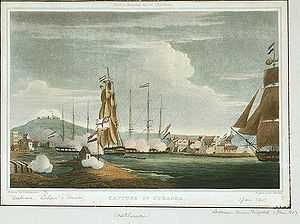HMS Latona (1781)
| Career (UK) | |
|---|---|
| Name: | HMS Latona |
| Operator: | Royal Navy |
| Ordered: | 22 March 1779 |
| Builder: | Edward Greaves's yard at Limehouse |
| Laid down: | October 1779 |
| Launched: | 13 March 1781 |
| Commissioned: | 21 April 1781 (after fitting out at Deptford Dockyard) |
| Honours and awards: | Naval General Service Medal with clasp “Curacoa 1 Jany. 1807”[1] |
| Fate: | 1813 hulked. 1816 sold. |
| General characteristics | |
| Tons burthen: | 944 20⁄94 (bm) |
| Length: | 141 ft 3 in (43.05 m) |
| Beam: | 38 ft 11 3⁄4 in (11.881 m) |
| Depth of hold: | 13 ft 6 in (4.11 m) |
| Propulsion: | Sail |
| Complement: | 270 (raised to 280 on 25 April 1780) |
| Armament: | UD: 28 x 18-pounder guns QD: 8 x 6-pounder guns + 6 x 18-pounder carronades Fc: 2 x 6-pounder guns + 4 x 18-pounder carronades Also 14 swivels |
HMS Latona was a 38-gun, 18-pounder gun armed fifth-rate frigate of the Royal Navy. She was designed by the senior surveyor John Williams. In this era it was common for each surveyor to produce independent designs for new ship types, and this design was a counterpoint to Edward Hunt's HMS Minerva; together the two draughts represent the prototype of the thirty-eight gun, 18-pounder armed frigate.
Latona, under the command of F. Sotheron, on 29 November 1796 captured the French Bordeaux-based privateer schooner Aigle about 107 leagues N by W from Lisbon. She had left out of Passayes, near Bayonne, on 6 November, but had captured nothing. She was pierced for 14 guns but carried on 12 small carriage guns, and had a crew of 62 men under the command of Francis Harimendy.[2]
Then a few days later, on 3 December, Latona captured the French brig Intrepide 40 leagues WNW of Lisbon. She was pierced for 18 guns but carried twelve 6-pounders, an 18-pounder carrronade, and a brass 12-pounder gun. During the chase she three all her guns overboard except for the 12-pounder and one 6-pounder, both of which she used as stern chasers, firing, but without effect, until Latona was almost alongside. She had a crew of 83 men abouar, under the command of M. Jean Candeau. On her cruise she had captured only one vessel, a galliot belonging to Bremen, which had been sailing from Faro to Liverpool with a cargo of fruit.[2]
Latona, commanded by T.L.M. Gosselin, captured the Spanish ketch Amphion, armed with 12 guns and 70 men at sea 22 October 1805.

On 1 January 1807 Latona, Arethusa, Anson, Fisgard, and Morne Fortunee captured Curaçao.[3] The Dutch resisted and Latona lost one men killed and two wounded; in all, the British lost three killed and 14 wounded. On the ships alone, the Dutch lost six men killed, including Commandant Cornelius J. Evertz, who commanded the Dutch naval force in Curaçao and seven wounded, of whom one died later. With the colony, the British captured the frigate Kenau Hasselar, the sloop Suriname (a former Royal Naval sloop), and two naval schooners. In 1847 the Admiralty authorized the issue of the Naval General Service Medal with clasp “Curacoa 1 Jany. 1807” to any surviving claimants from the action; 65 medals were issued.
At the Action of 10 February 1809, Latona was involved in the capture of HMS Junon in the West Indies. [4]
On 7 June 1809, commanded by Captain Hugh Pigot, Latona captured the French 36-gun frigate Félicité .[5]
Citations
- ↑ The London Gazette: no. 20939. p. 241. 26 January 1849.
- ↑ 2.0 2.1 The London Gazette: no. 14077. p. 1231. 26 December 1797.
- ↑ The London Gazette: no. 16003. pp. 241–243. 22 February 1807.
- ↑ James, Chamier, 1859 pp.5-7
- ↑ James, Chamier, 1859 p.23
References
- Gardner, Robert, The Heavy Frigate, Conway Maritime Press, London 1994.
- Winfield, Rif British Warships in the Age of Sail, 1793-1817, Chatham Publishing, London 2005.
- James, William; Chamier, Frederick (1837). The naval history of Great Britain: from the declaration of war by France in 1793 to the accession of George IV.
Richard Bentley, London. p. 568.
Url